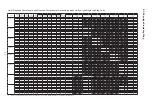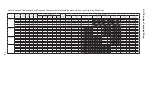
4
■
Based on the working load limit, angle of loading and type, select the chain diameter from “Table 1.
Slinging Methods and Working Load Limits”.
■
In case of the following working conditions, reduce the working load limit to 80% to use the chain sling.
1. Work that is carried out with high frequency or when the working load is applied continuously
2. Work in which vibration is applied continuously
3. Usage by incorporation in an automatic line
■
High-temperature work is subject to thermal effect, reducing the working load. Seeing “Table 2. Working
Load Limits due to Temperature”, take a reduction rate into account to select a chain diameter.
Overload is strictly prohibited. Check whether the sufficient working load
limit and chain diameter have been selected with respect to the actual load,
considering the working conditions, working environment, etc.
Table 1. Slinging Methods and Working Load Limits (Unit: t)
3. Preparation of Components
3-1 Selecting the Chain Diameter
DANGER
◎
For slinging methods that have a “
*
” mark, in situations where the chain is used by hooking on a grab hook (in order to adjust the length, etc.) the working load limits become
70% of the values shown in the above table. For slinging methods that do not have a “
*
” mark, no load reduction is required.
◎
The bold-faced numerical values in the tables are exclusive values for “When using the Large Master Link HMG/HMH” and “When using the Master Link HMF with Sub Links”
respectively.
When using
the Large
Master Link
HMG/HMH
When using
the Master
Link
HMF
with Sub
Links
Slinging method
Angle of loading θ
Chain
diameter
(mm)
Single
leg
Double legs
Triple and
quadruple legs
Double legs
Quadruple legs
Double
choke
hitch
Choke hitch
Endless
Slinging with hooks
Direct slinging
Double legs
Single
leg
Summary of Contents for Chain Sling 100
Page 27: ...27 Memo...
Page 28: ...Global Website kito com...
























